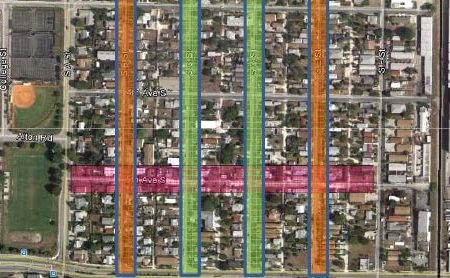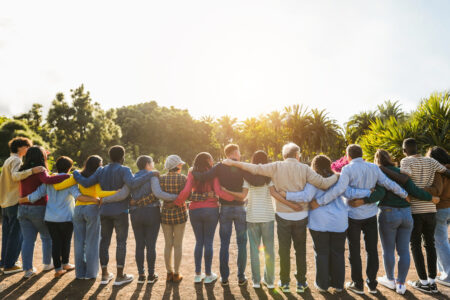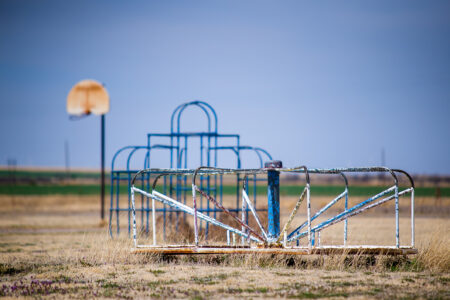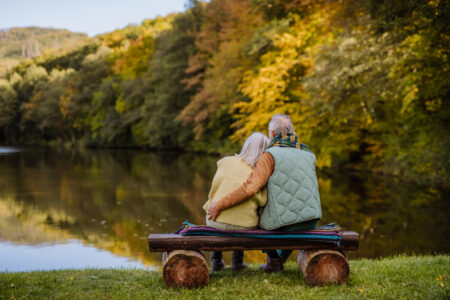Share On Social!
An abandoned alley in Lake Worth, Fla., was re-developed into an attractive greenway through team work and perseverance by a researcher, school district employee, city staff, and the community. The greenway, which is located near a school in a predominantly Latino area, will increase the area’s walkability and connect two neighborhoods to a nearby high school.
EMERGENCE
Awareness: Dr. Ruth McCaffrey, a trained nurse and professor at Florida Atlantic University, was keenly aware that obesity was a growing concern in Lake Worth, Fla. About 30% of the city’s 35,000 residents live in poverty, and 40% are Latino—with a growing number of families migrating there from Guatemala.
Several parts of town lack adequate spaces for physical activity, and the way the city was designed impedes physical activity. For instance, many city streets were unpaved and, in some areas, the only walkways that existed were dirt roads full of weeds, broken glass, and trash.
Learn: McCaffrey believed active spaces could help people get more exercise, but she also wanted to learn more about the therapeutic benefits that an outdoor, serene setting could offer. She wanted to see a park developed where people could both walk and enjoy the stress-relieving benefits of nature.
Through a doctoral student who had conducted a Google search for grants to build parks, she soon discovered the Open Spaces, Sacred Places grant, sponsored by the TKF Foundation, which aims to treat human health and the environment as an integrated whole. The grant sought to provide funds to develop attractive green spaces for underserved urban populations.
McCaffrey decided to try and secure the grant and attended an information session provided by TKF to learn more about writing the proposal. To learn more about the best way to apply, she tried to find and connect with community leaders who shared a similar vision. She contacted William Waters, director of Lake Worth’s Community Development Department, who informed her of the work of Erica Whitfield, a project coordinator with the School District of Palm Beach County, FL., who was working to prevent childhood obesity through the Healthy Kids, Healthy Communities (HKHC) program funded by the Robert Wood Johnson Foundation (RWJF).
Frame Issue: Waters arranged a meeting between McCaffrey, Whitfield and Christian Dabros, a project manager with the community redevelopment agency, and the team expressed interest in applying together for the grant and bringing more green space to Lake Worth.
Whitfield said not a lot of planning had gone into the city’s original layout, so there was little room to develop a new park. Nearly 27 miles of road had not been paved, necessitating a greater need for connectivity in the city. Because land was difficult to obtain and the city lacked paved roads, Waters suggested that the group create a greenway, which could simultaneously offer connectivity and space for activity.
The team drove around the city looking for the right spot for a greenway. They found an abandoned alley at Fifth Avenue South. The alley had ballards that blocked cars from entering, but when they saw it, they immediately envisioned a trail.
The group discussed how opening a walking trail along this alley could promote walkability, and the location would connect residents from the Royal Poinciana Neighborhood and Tropical Ridge Neighborhoods to Lake Worth High School.
“The focus…was to reconnect people with nature,” McCaffrey said. “There weren’t a lot of parks where people could walk.”
DEVELOPMENT
Education: The team presented their idea to a landscape designer to get some feedback. They also visited the homes of residents who lived in the area to discuss the idea of bringing a greenway to the alley and hear some of their thoughts.
Mobilization: Once they had a draft of the design and the information they needed for the Open Spaces, Sacred Places, grant application, they submitted their proposal.
After a year of waiting, they found out they were not selected.
They said they were disappointed, but decided not to give up.
McCaffrey urged Whitfield to take the grant application and told her: “If you can find a way to get this funded some other way, I really want to see it done.”
“It was a lot of work on her part to put together, and I didn’t want to let it die,” Whitfield said.
Whitfield, who was a member of The Bikes and Greenways Pedestrian Advisory Council (a committee of the Palm Beach Metropolitan Planning Organization [PBMPO]), sought alternative funding mechanisms. She knew of a grant offered every year through the PBMPO. The city was eligible to apply, but hadn’t ever applied. Whitfield said it would take some convincing to get the city on board for this $750,000 Transportation Alternatives Program (TAP) grant.
“There’s a lot of work that goes along with administrating grants that big,” Whitfield said. “So convincing the city to be on board was really difficult.”

Debate: To convince the city, Whitfield worked with the city’s Community Redevelopment Agency (CRA) and met with all the commissioners. At this point the city agreed to work in collaboration with the CRA to apply for the TAP grant.
Whitfield said the CRA is a special taxing district created in communities where they really need to improve an area. They take all of the taxes from a certain area (including businesses) and put them back into that area.
Before the group applied for the grant, Whitfield and another member of the team went around the neighborhoods located near the greenway to get neighbors’ input.
Some asked, “Are you going to mess up my parking?” Others wanted to ensure the greenway would meet their needs and not invade their privacy.
Whitfield explained that the walkway would offer them another mode of transportation, connect parts of the city, and offer them a safe and inviting place to walk and exercise. This helped ease the mind of residents and a few of them even signed a petition stating that they supported the construction of the greenway.
Because the grant required that the grantee do all of their own design work, Whitfield and the team had to convince the city to commit to doing all of the design work. They didn’t know what funds would be used for this, but after talking to the city manager and making their case for the greenway, they agreed to apply to the transportation alternative program in partnership with the CRA.
Bret Baronak of the PBMPO suggested that the project include bike lanes in addition to walkways. He explained how this would support the City of Lake Worth’s Bicycle Network Plan.
The city and CRA saw the value in adding bikeways to the plan and agreed to add two new bikeways that would cross the pathway to the project.
ENACTMENT
Activation: Groups like the Palm Beach School District’s Physical Education and Health Department, the Rotary Club of Lake Worth, The Lake Worth Arts and Cultural Community, the Genesis Neighborhood Association, and the Tropical Ridge Neighborhood Association, all drafted letters of support for the project.
In a letter of support, Mark Padilla, President of the Genesis Neighborhood Association, who owns a productions company, even offered to film and document the progression and transformation of the alley at no cost.
Christian Dabros of the CRA worked with Jeff Trompeter, P.E., of Civil Design Inc., to develop a budget of the projected expenses. The budget included landscaping costs and construction costs for items such as: ADA railings, crosswalk flashers, base rock import & subgrade, drainage structures, exfiltration trenches, maintenance of traffic signage, and National Pollutant Discharge Elimination System (NPDES) Compliance, among other expenses. Engineers estimated the project cost at $1.16 million.
Frame Policy: A plan for the Fifth Avenue South Bikeway and Pedestrian Project made its way to several local governing bodies. The plan called for connecting two neighborhoods with the Lake Worth Memorial Field, which sits just west of the proposed greenway.
The Lake Worth Memorial field is a place where games like football and soccer, as well as neighborhood events, regularly take place and it’s conveniently located south of Lake Worth High school.
If funded, the project would provide residents from nearby neighborhoods a safe and convenient form of active transportation to this place of recreation.
Landscaping, bike racks, benches, and an irrigation system were also part of the plans. On sections of the trail that intersected with street traffic, crosswalks with flashers were to be installed.
In addition to the greenway, approximately one mile of street bike lanes were added to the Fifth Avenue South Bikeway and Pedestrian Project proposal.
On April 2, 2013, The City of Lake Worth Commission adopted resolution no. 20-2013 which supports the Fifth Avenue South Bikeway and Pedestrian Project and authorizes the application to the transportation alternatives program.
On April 9, 2013, the CRA passed a similar resolution (no. 2013-01) in support of submitting the TAP grant application.
Change: The team submitted the application to the PBMPO.
On April 25, 2013, seven groups who had applied for the TAP grant presented their proposals to the PBMPO’s Bicycle-Greenways Pedestrian Advisory Committee (BGPAC). That same day the committee approved the grant for the Fifth Avenue South Bikeway and Pedestrian Project, for a total of $750,000.
Whitfield later found out that the project had been the top choice of the MPO’s board members.
IMPLEMENTATION
Implementation: Grant award funds will be dispersed to the city during the 2016-17 fiscal year, at which point it will take up to four years to finish the project.
The Fifth Avenue South Bikeway and Pedestrian Project will span five blocks and 1,520 feet.
Equity: The community has expressed a lot of interest in developing multimodal forms of transportation.
“The City Manager has said that he wants to use the design as a model for the rest of the city,” Whitfield said. “This is a beautiful way to develop the city.”
The CRA has come forward with an extra $25,000 in funds for the project. This will help cover the costs of design, planning, and contingency, which are not covered by the TAP grant.
Sustainability: Once the project is complete, the new greenway will be maintained by the city’s parks system.

Additional links:
See Erica Whitfield’s HKHC profile here.
This success story was produced by Salud America! with support from the Robert Wood Johnson Foundation.
The stories are intended for educational and informative purposes. References to specific policymakers, individuals, schools, policies, or companies have been included solely to advance these purposes and do not constitute an endorsement, sponsorship, or recommendation. Stories are based on and told by real community members and are the opinions and views of the individuals whose stories are told. Organization and activities described were not supported by Salud America! or the Robert Wood Johnson Foundation and do not necessarily represent the views of Salud America! or the Robert Wood Johnson Foundation.
ABOUT THE PROGRAM
Salud America! The RWJF Research Network to Prevent Obesity Among Latino Children is a national program of the Robert Wood Johnson Foundation. The program aims to educate researchers, decision-makers, community leaders, and the public in contributing toward healthier Latino communities and seeking environmental and policy solutions to the epidemic of Latino childhood obesity. The network is directed by the Institute for Health Promotion Research at the University of Texas Health Science Center at San Antonio.
For more information, visit http://www.salud-america.org.
By The Numbers
33
percent
of Latinos live within walking distance (<1 mile) of a park
This success story was produced by Salud America! with support from the Robert Wood Johnson Foundation.
The stories are intended for educational and informative purposes. References to specific policymakers, individuals, schools, policies, or companies have been included solely to advance these purposes and do not constitute an endorsement, sponsorship, or recommendation. Stories are based on and told by real community members and are the opinions and views of the individuals whose stories are told. Organization and activities described were not supported by Salud America! or the Robert Wood Johnson Foundation and do not necessarily represent the views of Salud America! or the Robert Wood Johnson Foundation.



